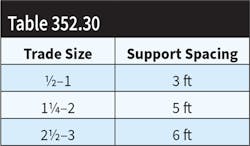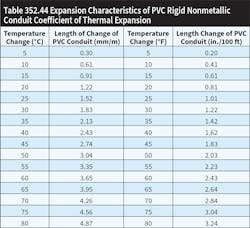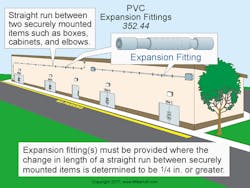All questions and answers are based on the 2017 NEC.
Q. What is the NEC requirement for securing and supporting PVC conduit?
A. PVC conduit must be fastened and supported in accordance with Sec. 352.30(A) and (B) so movement from thermal expansion and contraction is permitted.
Secured. PVC conduit must be secured within 3 ft of every box, cabinet, or termination fitting, such as a conduit body [Sec. 352.30(A)].
Supports. PVC conduit must be supported at intervals not exceeding the values in Table 352.30, and the raceway must be fastened in a manner that permits movement from thermal expansion or contraction [Sec. 352.30(B)].
PVC conduit installed horizontally in bored or punched holes in wood or metal framing members, or notches in wooden members, is considered supported, but the raceway must be secured within 3 ft of termination.
Q. What are the Code requirements for expansion fittings in PVC conduit runs?
A. If PVC conduit is installed in a straight run between securely mounted items, such as boxes, cabinets, elbows, or other conduit terminations, expansion fittings must be provided if the expansion or contraction length change, in accordance with Table 352.44, is expected to be ¼ in. or greater [Sec. 352.44], as shown in the Figure.
When determining the number and setting of expansion fittings, you must be sure to actually read the manufacturer’s documentation. For example, instructions for one manufacturers expansion fittings for PVC states that when the PVC has sunlight exposure, we must add 30°F to the high ambient temperature.
These materials are provided to us by Mike Holt Enterprises of Leesburg, Fla. To view additional Code training materials offered by this company, visit www.mikeholt.com.About the Author

Mike Holt
Mike Holt is the owner of Mike Holt Enterprises (www.MikeHolt.com), one of the largest electrical publishers in the United States. He earned a master's degree in the Business Administration Program (MBA) from the University of Miami. He earned his reputation as a National Electrical Code (NEC) expert by working his way up through the electrical trade. Formally a construction editor for two different trade publications, Mike started his career as an apprentice electrician and eventually became a master electrician, an electrical inspector, a contractor, and an educator. Mike has taught more than 1,000 classes on 30 different electrical-related subjects — ranging from alarm installations to exam preparation and voltage drop calculations. He continues to produce seminars, videos, books, and online training for the trade as well as contribute monthly Code content to EC&M magazine.




